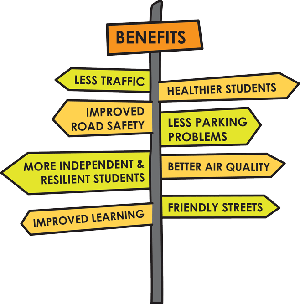Active Transport For Kids
Using free or cheap alternate transport (walking, cycling, scooting or even taking public transport) to and from school can greatly increase the amount of physical activity children achieve across the day, and costs far less than fuel to get there and back.
Remember, if you live too far from school, part of the way is okay too. Some tips to start walking and riding to school safely:
1. Talk
Talk about when and how your child will be traveling to school. Do they want to cycle, walk or ride a scooter?
2. Plan
Plan the route as a family. Learn which streets are safest. Quieter streets, those with designated paths and those which have suitable surfaces for the chosen mode of transport are important to avoid mishaps. If it makes you feel more comfortable, testing the journey yourself is a great way to be sure you're on the right track.
3. Check
If using equipment such as bikes or scooters to get to school, make sure the equipment is in a good workable condition, and appropriate clothing is worn. Remember Australian standard quality helmets are compulsory throughout Australia when riding bikes.
4. Try
When you're comfortable with the planned path, try the journey as a family on a weekend.
5. Accompany
Accompany them on the journey to school, as they gain confidence and learn and practice road safety, shorten your trips and accompany them part of the way until they are able to ride themselves.
6. Invite
If there are others in the neighbourhood who are heading to the same school, why not go together?
Tip
The earlier children are exposed to active transport, the more experience and confidence they'll gain over time. If walking kids to school, taking younger siblings in a pram would be a great start and an enjoyable family activity.

Part of the way is ok too!
Taking active transport doesn't have to mean going the whole way on foot or two wheels.
Some families find it convenient to drop children off at school on the way to work. Others live too far to walk, cycle or scoot. Here are some options so your family doesn't have to miss out on the benefits:
- Public transport is a great option – walk from home to the bus or train.
- Park your car a few blocks from the school and do a short walk to school. Organise a pick up location with the children that they can walk to. It may even avoid slow traffic.
- If you can't do active transport to or from school, try heading to a playground, park or swimming pool for some afterschool exercise!
- Take a look at our tips for getting started. Remember any chance to introduce children to active transport whilst young will increase their road awareness and experience and will prepare them for their older more independent years.
- Check out Healthy Workplace WA program's video, 'Leave the car at home: get active and save money on your way to work' to see Georgina and her son's TravelSmart story.
A Smart way to get to school
A Walking School Bus works like a bus, picking up 'passengers' along the way at designated 'bus stops' except everyone is walking!
Walking School Buses are a fun way for local children to walk to school together regularly - thanks to adult volunteers, usually parents, who take turns to walk with the group. Benefits of participating in a Walking School Bus include:
- Reduce traffic congestion around schools; making roads, and active transport safer
- Promote children's learning of road safety
- Promote social connected-ness; walking is a great way to get to know your neighbourhood – and neighbours!
- Children arrive ready to learn more in the classroom
- Perfect for busy parents who do not always have the time to walk alongside their children everyday
A Walking School Bus is just one way to start becoming active.
Cycling
Cycling is a popular way to get to school for many children. It is important to have the correct equipment to avoid injuries and ensure your child arrives safely at school.
Check out our 'Out and 'About' section for more information on how to 'get active as a family' and how to get kids started riding bikes.
Take a look at the Department of Transport (WA)'s 'Bike Maintenance' and 'Choosing a Bike' links below.
